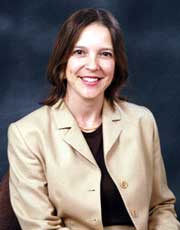ALS Research Today
The Continuation of the Conversation with The ALS Association's Science Director Lucie Bruijn, PhD
To read the full interview, please visit the Spring 2004 issue of A Reason for Hope
 HOPE: Why do you think the scientists are so eager to work in the field of ALS research? HOPE: Why do you think the scientists are so eager to work in the field of ALS research?
BRUIJN: This is a very exciting time for those of us working on ALS. We now have the tools to test the important questions. We have several animal model systems-a mouse, a fly and a rat model. There is also the ability to test aspects of the disease in a worm. Scientists from fields of Huntington's disease and Parkinson's disease are bringing their expertise to the ALS field. In many ways, neurodegenerative disease research tackles similar questions. Although the cells and genes involved are different, the processes are similar. In addition, similar model systems can be developed across the different diseases. Several compounds are being used in a number of neurodegenerative diseases.
HOPE: What do young scientists bring to the effort?
BRUIJN: Young scientists are incredibly important. This is when their enthusiasm is peaking, and they are making career choices. The ALS Association realizes the importance of attracting young scientists. We offer workshops that enable young scientists to come and talk about their work in a friendly, nurturing environment, and they have the opportunity to collaborate and initiate new projects with colleagues and peers. These young scientists are explorative and eager to investigate new ideas. They represent the future of ALS research, so their excitement is critical for our success. ALS presents huge challenges with many tantalizing areas to explore, and the young investigators can bring their own, fresh hypotheses to the table. Today, many scientists are working together and collaborating, and this also attracts young people. This disease is fascinating, and yet so devastating. The need to make an impact is absolutely compelling.
HOPE: The Milton Safenowitz Post-Doctoral Fellowship for ALS Research is the only ALS-specific post-doctoral fellowship program in the country. The inaugural fellowship was recently awarded with support from the Lawrence and Isabel Barnett Charitable Foundation. What role will this post-doctoral fellowship program play in bringing in new scientists?
BRUIJN: This is a very essential program that has great potential for finding answers to ALS. In fact, it was a post-doctoral fellowship that launched me into ALS research. The ALS Association's fellowship program offers a great opportunity to recruit new investigators for ALS research while their minds are open to "out of the box" thinking. Although they will be working in a large laboratory, the fellowship recipients feel a strong sense of ownership of their project. They perform the hard work in the lab with the guidance of the principal investigators. This is an incredible way to get new people excited about exploring new ideas.
HOPE: As we continue to face a tight economy, what are the challenges that you see in obtaining funding for ALS research, both from the public sector and private industry?
BRUIJN: Budget cuts and the economic situation present an enormous challenge. We must make sure that the government and the private sector maintain a strong focus on ALS. They need to understand the promise and the excitement of this disease as an area for investment. In the future, I believe there will be increased industry involvement. Admittedly, ALS impacts a smaller number of people than, say Alzheimer's disease. This is due in part because so many people succumb to ALS within 2 to 5 years. However, the visible characteristics of ALS make it easier to score test results on an animal model. For example, if you can find a compound that will change the progression of the disease, you will be able see a change in hind limb weakness. That's easier to score than many other degenerative disease models. With tangible results, industry is likely to want to get involved. For industry, neurodegenerative diseases and diseases of aging are very important, but there haven't been very many success stories. A highly effective drug for Alzheimer's hasn't been developed. There are drugs for Parkinson's, but we still don't have a cure. So a successful investment would be attractive to industry, even if the market is smaller. Small biotechnology companies, rather than large pharmaceutical companies, are investing in ALS research, recognizing the high risk but high benefit for their companies. They are able to develop the technologies and focus on ALS as a proof of principle. The likelihood is that many of the mechanisms in ALS are occurring in other neurodegenerative diseases, so we believe there may be one compound that will treat many neurodegenerative diseases. My message to industry is that ALS is a disease worth vesting in.
HOPE: Do you see pharmaceutical companies playing a larger role in the future?
BRUIJN: Our grant programs indicate there is increased interest among the biotechnology companies. We're forming partnerships with academia and industry, and I do think that there'll be an increased role that they'll be playing - especially in clinical trials of compounds that have been used for other diseases, such as the current trials of Celebrex.
HOPE: What are some of the things we know about the disease?
BRUIJN: We know the disease is likely caused by multiple factors and manifests itself very differently from patient to patient. Many cell types are involved besides the motor neuron. The cell death processes are now more clearly understood providing potential drug targets. Some of the unique properties of motor neurons, such as their long axons, are likely to be the reasons why they are vulnerable. And, there is increasing awareness that axonal transport is disrupted, which is a critical process for providing nutrients back and forward from the muscle to the neuron.
HOPE: What has the development of the mouse model done for the ALS research?
BRUIJN: The mouse model for ALS has certainly advanced the research in the last several years. It is striking that by introducing a piece of human mutant SOD1 DNA in every cell of the mouse, it develops disease similar to ALS affecting specifically the motor system. The progression is rapid and easy to follow. First, it affects one hind limb, spreads to another hind limb, and then the fore limbs. The model has provided investigators with an incredible tool. Until the discovery of the gene associated with ALS, there had not been a model that resembled the human disease as closely. When patients come into the clinic, they already have the disease. Consequently, we can't tell how long they have had the disease or how fast it is progressing. The current thought is that this disease happens by a slow accumulation of something, and at some point, the cells can't take the load anymore, then the patient's condition goes downhill very fast. We have been able to track this in a mouse model. With the mouse model, we now can see the affect of compounds administered well before disease onset, as the disease begins to develop, and after the disease has taken hold. You can introduce a compound into the model and look to see if there is a reaction. This also applies to stem cell therapy and gene therapy. You can attempt to change the course of the disease. This dramatically opens up the possibilities for understanding ALS.
HOPE: What is the landscape for discovery in the next few years?
BRUIJN: I think discovery of new genes are on the imminent horizon. That will open up a way to develop new disease models and begin to piece the puzzle together. Human drug testing in the clinic will increase. The challenge will be to sort out which trials to run and which are the more promising drugs. We have begun to accept the complexity of stem cells, and investigators are thinking about applying stem cells in a more innovative way, not just to replace dying neurons, but also to replace healthy neighboring cells.
|



